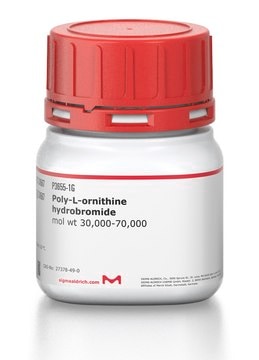Key Documents
P4957
Poly-ʟ-Ornithine
synthetic, mol wt 30,000-70,000, liquid, 0.01%, suitable for cell culture
About This Item
Polecane produkty
product name
Poly-L-ornithine solution, mol wt 30,000-70,000, 0.01%, sterile-filtered, BioReagent, suitable for cell culture
pochodzenie biologiczne
synthetic
Poziom jakości
sterylność
sterile-filtered
linia produktu
BioReagent
Postać
solution
masa cząsteczkowa
30,000-70,000
opakowanie
pkg of 50 mL
stężenie
0.01%
metody
cell culture | mammalian: suitable
pokrycie powierzchni
4 μg/cm2
zanieczyszczenia
endotoxin, tested
Warunki transportu
ambient
temp. przechowywania
2-8°C
ciąg SMILES
Br.NCCCC(N)C(O)=O
InChI
1S/C5H12N2O2.BrH/c6-3-1-2-4(7)5(8)9;/h4H,1-3,6-7H2,(H,8,9);1H
Klucz InChI
GWRQMKDBBHFVIZ-UHFFFAOYSA-N
Opis ogólny
Zastosowanie
Działania biochem./fizjol.
Uwaga dotycząca przygotowania
produkt powiązany
Kod klasy składowania
10 - Combustible liquids
Klasa zagrożenia wodnego (WGK)
WGK 3
Temperatura zapłonu (°F)
Not applicable
Temperatura zapłonu (°C)
Not applicable
Certyfikaty analizy (CoA)
Poszukaj Certyfikaty analizy (CoA), wpisując numer partii/serii produktów. Numery serii i partii można znaleźć na etykiecie produktu po słowach „seria” lub „partia”.
Masz już ten produkt?
Dokumenty związane z niedawno zakupionymi produktami zostały zamieszczone w Bibliotece dokumentów.
Klienci oglądali również te produkty
Produkty
Poly-Lysine enhances electrostatic interaction between negatively-charged ions of the cell membrane and positively-charged surface ions of attachment factors on the culture surface. When adsorbed to the culture surface, it increases the number of positively-charged sites available for cell binding.
Poli-lizyna zwiększa wiązanie komórek z dodatnio naładowanymi jonami powierzchniowymi, optymalizując interakcje elektrostatyczne na powierzchniach hodowli w celu zwiększenia przyczepności komórek.
Frequently asked questions about neural stem cells including NSC derivation, expansion and differentiation.
Derivation and characterization of functional human neural stem cell derived oligodendrocyte progenitor cells (OPCs) that efficiently myelinate primary neurons in culture.
Protokoły
A stem cell culture protocol to generate 3D NSC models of Alzheimer’s disease using ReNcell human neural stem cell lines.
Protokół hodowli komórek macierzystych do generowania modeli 3D NSC choroby Alzheimera z wykorzystaniem linii ludzkich neuronalnych komórek macierzystych ReNcell.
Step-by-step culture protocols for neural stem cell culture including NSC isolation, expansion, differentiation and characterization.
Nasz zespół naukowców ma doświadczenie we wszystkich obszarach badań, w tym w naukach przyrodniczych, materiałoznawstwie, syntezie chemicznej, chromatografii, analityce i wielu innych dziedzinach.
Skontaktuj się z zespołem ds. pomocy technicznej











